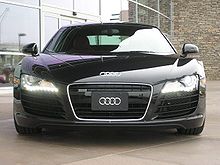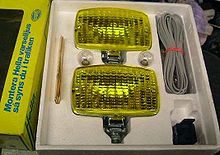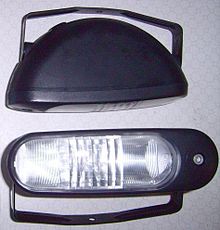- Daytime running lamp
-
A daytime running lamp (DRL, also daylight running lamp or daytime running light) is an automotive lighting device on the front of a roadgoing motor vehicle, installed in pairs, automatically switched on when the vehicle is moving forward, emitting white, yellow, or amber light to increase the conspicuity of the vehicle during daylight conditions.
Contents
Implementations
Depending on prevailing regulations and vehicle equipment, the daytime running light function may be implemented by functionally-specific lamps, by operating the low-beam headlamps or fog lamps at full or reduced intensity, by operating the high-beam headlamps at reduced intensity, or by steady-burning operation of the front turn signals. Compared to any mode of headlamp operation to create the daytime running light, functionally-dedicated DRLs maximize the potential benefits in safety performance and minimize fuel consumption, glare, motorcycle masking, and other potential drawbacks.[1]
 LED DRLs on an Audi R8
LED DRLs on an Audi R8
Safety performance
Numerous studies done worldwide since the 1970s have tended to conclude that daytime running lights improve safety.[1][2][3] A 2008 study by the U.S. National Highway Traffic Safety Administration analysed the effect of DRLs on frontal and side-on crashes between two vehicles and on vehicle collisions with pedestrians, cyclists, and motorcyclists. The analysis determined that DRLs offer no statistically-significant reduction in the frequency or severity of the collisions studied, except for a reduction in light trucks' and vans' involvement in two-vehicle crashes by a statistically-significant 5.7%.[4]
Effect of ambient light
The daytime running light was first mandated, and safety benefits first perceived, in Scandinavian countries where it is frequently and persistently dark during daytime hours in winter time. As ambient light levels increase, the potential safety benefit decreases while the DRL intensity required for a safety improvement increases. The safety benefit produced by DRLs in relatively dark Nordic countries is roughly triple the benefit observed in relatively bright Israel and America.[1]
Effect on motorcycle safety
In many countries, every motorcycle's low beam headlamp has been wired to illuminate whenever the engine is running, either as a matter of law or of voluntary industry practice. Some motorcycling advocacy groups are concerned over the potential for reduced motorcycle conspicuity with the introduction of headlamp-based DRLs on cars and other dual-track vehicles, since it means motorcycles are no longer the only vehicles displaying headlamps during the day.[5] Some researchers have suggested that amber DRLs be reserved for use exclusively on motorcycles, in countries where amber is not presently a permissible color for DRLs on any vehicles,[6] while other research has concluded there is a safety disbenefit to two 90 mm x 520 cd DRLs on motorcycles in comparison to one 190 mm x 270 cd dipped beam headlight. The latter result suggests that DRL luminous area may have an important influence on its effectiveness.[7]
Environmental impact
 LED daytime running lights on Audi A4
LED daytime running lights on Audi A4
DRL power consumption varies widely depending on the implementation. Current production DRL systems consume from 8 watts (dedicated LED system) to over 200 W (headlamps and all parking, tail, and marker lights on). International regulators, primarily in Europe, are working to balance the potential safety benefit offered by DRL with the increased fuel consumption due to their use. Because the power to run the DRLs must be produced by the engine, which in turn requires burning additional fuel, high-power DRL systems increase CO2 emissions sufficiently to affect a country's compliance with the Kyoto protocol on greenhouse gas emissions.[8] For that reason, low-power solutions are being encouraged[9] and headlamp-based systems are not allowed when DRLs become mandatory in Europe at the beginning of 2011. LEDs and low-power, high-efficacy, long-life light bulbs produce appropriate amounts of light for an effective DRL without significantly increasing fuel consumption or emissions. Fuel consumption reductions of up to 0.5 mpg may be found when comparing a 55 W DRL system to a 200 W DRL system.[10] In 2006, the UK's Department of Transport also found significant reductions in emissions and fuel consumption when comparing a 42 W DRL system to a 160 W full headlight DRL systems.[11] DRL fuel consumption can be reduced to insignificant levels by the use of 8 to 20 W DRL systems based on LEDs or high-efficacy filament bulbs.
Worldwide
European Union
European Union Directive 2008/89/EC requires all passenger cars and small delivery vans first type approved on or after 7 February 2011 in the EU to come equipped with daytime running lights.[12] The mandate will extend to trucks and buses in August 2012.[13] The EU Directive requires that the DRL function must be produced by functionally specific lamps meeting the requirements of ECE Regulation 87 and mounted to the vehicle in accord with ECE Regulation 48.[14] Functional piggybacking, such as operating the headlamps or front turn signals or fog lamps as DRLs, is not permitted.[15]
Individual states within the European Union
Germany, Spain, France and others have encouraged or required daytime use of low-beam headlamps on certain roads at certain times of year, Ireland encourages and Bulgaria requires the use of low-beam headlights at all times during winter, Italy, Hungary and Romania require daytime running lamps outside populated areas, and Czech Republic, Estonia, Latvia, Lithuania, Poland, Slovakia and Slovenia require the use of full or reduced voltage low-beam headlights at all times. Most EU states no longer significantly disagree over whether DRLs should be required, permitted, or prohibited; by member-state consensus, since February 2011 ECE R48 has required DRLs conforming to ECE R87 on all new motor vehicles.[16][17] DRLs compliant with R87 emit white light of between 400 and 1200 candelas.[18]
 Hella DRL retrofit kit offered in Sweden in the 1970s. Package text reads "Install Hella perception lights so you are seen in traffic".
Hella DRL retrofit kit offered in Sweden in the 1970s. Package text reads "Install Hella perception lights so you are seen in traffic".
DRLs were first mandated in Scandinavian countries, where ambient light levels in the winter are generally low even during the day. Sweden was the first country to require widespread DRLs in 1977. At the time, the function was known as varselljus ("perception light" or "notice light"). The initial regulations in these countries favored devices incorporating 21-watt signal bulbs identical to those used in brake lamps and turn signals, producing yellow or white light of approximately 400 to 600 candelas on axis, mounted at the outer left and right edges of the front of the vehicle. Finland adopted a daytime-light requirement in 1972 on rural roads in wintertime, and in 1982 on rural roads in summertime and 1997 on all roads all year long; Norway in 1986, Iceland in 1988, and Denmark in 1990. To increase manufacturer flexibility in complying with the requirement for DRLs, the daytime illumination of low-beam headlights was added as an optional implementation. Given the ECE headlamp specifications in use in those countries, such an implementation would produce approximately 450 cd axially.
United Kingdom
U.K. regulations briefly required vehicles first used on or after 1 April 1987 to be equipped with a dim-dip device[19] or functionally-dedicated daytime running lamps, except those vehicles type-approved to ECE Regulation 48 regarding installation of lighting equipment—this exception was made because ECE R48 did not require dim-dip or daytime running lights, and while countries signatory to the ECE Regulations are permitted to maintain their own national regulations as an option to the ECE regulations, they are not permitted to bar vehicles approved under the ECE regulations. The dim-dip system operated the low beam headlamps (called "dipped beam" in the UK) at between 10% and 20% of normal low-beam intensity. The running lamps permitted as an alternative to dim-dip were required to emit at least 200 candela straight ahead, and no more than 800 candela in any direction. In practice, most vehicles were equipped with the dim-dip option rather than the running lamps.[19]
The dim-dip lights were not intended for use as daytime running lights. Rather, they operated when the engine was running and the driver switched on the front position (parking) lamps. Dim-dip was intended to provide a nighttime "town beam" with intensity between that of the parking lamps commonly used at the time by British drivers in city traffic after dark, and low beam headlamps; the former were considered insufficiently intense to provide improved conspicuity in conditions requiring it, while the latter were considered too glaring for safe use in built-up areas. The UK was the only country to require such dim-dip systems, though vehicles so equipped were sold in other Commonwealth countries with left-hand traffic.[20]
In 1988, the European Commission successfully prosecuted the UK government in the European Court of Justice, arguing that the UK requirement for dim-dip was illegal under EC directives prohibiting member states from enacting vehicle lighting requirements not contained in pan-European EC directives. As a result, the UK requirement for dim-dip was quashed.[19] Nevertheless, dim-dip systems remain permitted, and while such systems are not presently as common as they once were, dim-dip functionality was fitted on many new cars well into the 1990s.[citation needed]
Russia
Russian national regulations which come into operation from 23 September 2010 required use of lowbeam or DRL anytime anywhere. DRL should have intensivity from 400 to 800 cd and lighted surface square 40 cm2.
Canada
Canada Motor Vehicle Safety Standard 108 requires DRLs on all new vehicles made or imported after January 1, 1990. Canada's proposed DRL regulation was essentially similar to regulations in place in Scandinavia, with an axial luminous intensity limit of 1,500 candela, but automakers claimed it was too expensive to add a new front lighting device, and would increase warranty costs (by dint of increased bulb replacements) to run the low beams. After a pitched regulatory battle, the standard was rewritten to permit the use of reduced-voltage high beam headlamps producing up to 7,000 axial candela, as well as permitting any light color from white to amber or selective yellow. These changes to the regulation permitted automakers to implement a less costly DRL, such as by connecting the high beam filaments in series to supply each filament with half its rated voltage, or by burning the front turn signals full time except when they are actually flashing as turn indicators.
United States
Shortly after Canada mandated DRLs, General Motors, interested in reducing the build variations of cars for the North American market, petitioned the U.S. National Highway Traffic Safety Administration in 1990 to permit (but not require) US vehicles to be equipped with DRLs like those in Canada.[21] NHTSA objected on grounds of the potential for high-intensity DRLs to create problems with glare and turn signal masking, and issued a proposed rule in 1991 that specified a maximum intensity of 2,600 cd.[21] Industry and safety-watchdog reacted with great controversy to the proposed rule,[21] and eventually the glare objections were set aside and most of the same types of DRLs allowed in Canada were permitted but not required effective with the 1995 model year.[21] General Motors immediately equipped most (and, in following years, all) of its vehicles with DRLs beginning with the Chevrolet Corsica. Saab, Volkswagen, Volvo, Suzuki and Subaru gradually introduced DRLs in the U.S. market beginning in 1995. In recent years, Lexus has installed high-beam or turn signal based DRLs on US models. Some Toyota models come with DRLs as standard or optional equipment, and with a driver-controllable on/off switch. Starting in the 2006 model year, Honda began equipping their U.S. models with DRLs, mostly by reduced-intensity operation of the high beam headlamps.
Public reaction to DRLs, generally neutral to positive in Canada, is decidedly mixed in the U.S. Thousands of complaints regarding glare from DRLs were lodged with the DOT shortly after DRLs were permitted on cars, and there was also concern that headlamp-based DRLs reduce the conspicuity of motorcycles, and that DRLs based on front turn signals introduce ambiguity into the turn signal system.[22] In 1997, in response to these complaints and after measuring actual DRL intensity well above the 7,000 cd limit on vehicles in use, DOT proposed changes to the DRL specification that would have capped axial intensity at 1,500 candelas, a level nearly identical to the European 1,200 cd and identical to the initially-proposed Canadian limit.[21] During the open comment period, a volume of public comments were received by NHTSA in support of lowering the intensity or advocating the complete elimination of DRLs from U.S. roads. Automaker sentiment generally ran along consistent lines, with European automakers experienced at complying with European DRL requirements voicing no objection to the proposal, and North American automakers vociferously repeating the same objections they raised in response to Canada's initial 1,500-cd proposal.[22][23] The NHTSA proposal for DRL intensity reduction was rescinded in 2004,.[24] pending agency review and decision on a petition filed in 2001 by General Motors, seeking to have NHTSA mandate DRLs on all U.S. vehicles.[25] The GM petition was denied by NHTSA in 2009, on grounds of severe methodological and analytical flaws in the studies and data provided by GM as evidence for a safety benefit to DRLs.[25] In denying the petition, NHTSA said
(…)the agency remains neutral with respect to a policy regarding the inclusion of DRLs in vehicles (…) we do not find data that provides a definitive safety benefit that justifies Federal regulation (…) manufacturers should continue to make individual decisions regarding DRLs in their vehicles.[25]
Australia
DRLs are permitted but not required in Australia, though Australian automotive authorities are interested in introducing DRL requirements.[26]
See also
References
- ^ a b c A Review of Daytime Running LightsPDF (1.7 MB)
- ^ Review of the Literature on Daytime Running Lights
- ^ IIHS: North American DRL studies
- ^ Wang, Jing-Shiarn (September). "The Effectiveness of Daytime Running Lights for Passenger Vehicles" (PDF). NHTSA Technical Report. Washington. D.C.: National Highway Traffic Safety Administration. pp. 116. http://www.regulations.gov/fdmspublic/ContentViewer?objectId=090000648070b5b6&disposition=attachment&contentType=pdf. Retrieved 2009-03-04PDF
- ^ European Agenda for Motorcycle SafetyPDF
- ^ Paine, Michael; David Paine, Jack Haley, Samantha Cockfield. "Daytime Running Lights for Motorcycles" (PDF). ESV19. http://members.optusnet.com.au/carsafety/esv19_paine_mc_drl.pdf. Retrieved 2009-03-22.
- ^ Zellner, John; Nicholas Rogers, Jacques Compagne, Jan Paul Peters (September 2007). "Development of a New Methodology for Measuring the Behavioural Conspicuity of Motor Vehicles". 7th International Symposium on Automotive Lighting. Herbert Utz Verlag GmbH. pp. 249–257. http://www.utzverlag.de.
- ^ DRL fuel consumption calculations
- ^ FIA Brussels report on costs & benefits of various DRL implementations
- ^ US Federal Register (7 August 1998). "Notice of Proposed Rulemaking: FMVSS 108 (Daytime Running Lights)" (PDF). NHTSA, p. 57 ¶ 2. http://dmses.dot.gov/docimages/pdf29/41090_web.pdf. Retrieved 2007-10-05.
- ^ Transport Research Laboratories (17 November 2006). "Daytime Running Lights (DRL): A Review of the Reports from the European Commission" (PDF). European Commission: Transport and Road Safety. http://ec.europa.eu/transport/roadsafety_library/consultations/drl_20060727/drl_trl.pdf. Retrieved 2007-10-20.
- ^ Europa.eu Press Release "New cars equipped with daytime running lights as of today"
- ^ European Commission Enterprise and Industry web page on DRLs
- ^ E.U. Directive 2008/89/EC
- ^ DRL Mandate Takes Effect in Europe, R48 Countries (subscription required)
- ^ EU to make DRLs mandatory from 2011
- ^ AL-Automotive Lighting DRL info
- ^ ECE Regulation 87, Revision 2
- ^ a b c Gaynor, Mark. "UK Dim-Dip Running Lights Regulatory History". D. Stern. http://dastern.torque.net/techdocs/dimdip.html. Retrieved 14 August 2006.
- ^ I.l.p.e.. "Memorandum submitted by the Institution of Public Lighting Engineers". D. Stern. http://dastern.torque.net/techdocs/DimDip2.html. Retrieved 14 August 2006.
- ^ a b c d e Federal Register 98-20918 NPRM: Federal Motor Vehicle Safety Standards Lamps, Reflective Devices, and Associated Equipment
- ^ a b docket for DRL glare complaints
- ^ Aborted NHTSA rulemaking to reduce DRL glare, with public complaints
- ^ NHTSA docket for withdrawal of intended rulemaking to reduce DRL glare
- ^ a b c Federal Register E9-15314: Denial of GM Petition to Mandate DRLs
- ^ ACRS: Daytime Running Lights
External links
- European Union Directive 2008/89/EC which mandates Daylight Running Lights on all new cars throughout the EU.
Categories:- Lamps
- Automotive technologies
Wikimedia Foundation. 2010.



